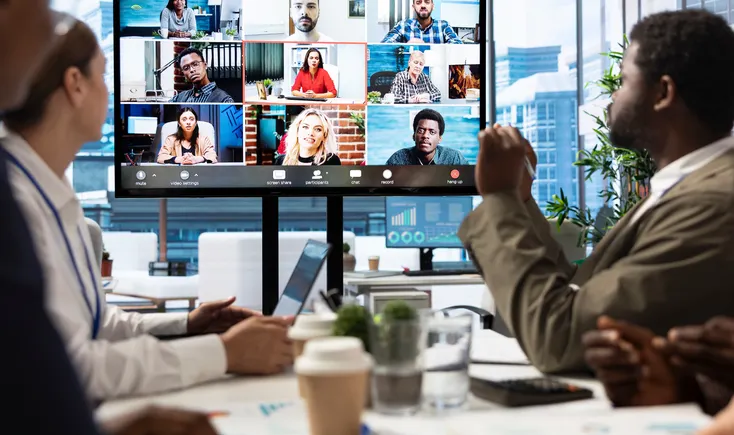Global teams don’t fall apart because of distance — they fall apart because they aren’t built with cohesion in mind.
With almost 90% of organizations now embracing some form of “workplace flexibility”, the old single-office model of work is no longer relevant. But flexibility without intention creates friction fast. It’s not just that distributed employees don’t benefit from the simple camaraderie an office provides: Being spread across time zones stretches communication thin and creates invisible silos. The result is teams that look global on paper but behave local in practice.
Building a unified global team is possible — but only if HR leads the design. Here’s how to do it with clarity, equity, and cultural intelligence.
1. Hire problem solvers
It all starts with hiring the kinds of people that can thrive in a global environment. Managers should look for people who can thrive amid the uncertainty and complexity inherent in global organizations, and HR should emphasize the importance of skills like communication, problem-solving, and comfort with ambiguity.
Distributed teams often face more uncertainty than in-office teams due to delays in responses, unclear workflows, and the lack of nonverbal cues. Studies show 86% of remote workers report some level of burnout, compared with 70% of their in-office peers. Global employees, therefore, need the ability to handle these challenges productively rather than being overwhelmed.
But knowing which soft skills you need is only half the work — you also need the right interview techniques to spot them. Despite being critical in a global workplace, only 60% of employers actively evaluate candidates for problem-solving abilities. A CV alone won’t give you the full picture: Ask candidates to describe a time they handled conflict, collaborated across locations, or managed a challenging project. Problem-solving tasks can also reveal whether a candidate is suited for distributed teamwork.
2. Build inclusive onboarding that works anywhere
After finding the right people, the work of building an inclusive team across cultures, generations, and backgrounds moves to onboarding. As organizations hire globally, HR teams need processes that respect individual differences while grounding everyone in a shared culture.
According to Multiplier’s Senior Vice President, People and Culture, Gerald Menezes, a comprehensive onboarding framework typically includes four components:
- Organizational onboarding: Covering the business model, leadership, financials, customers, and revenue
- Cultural onboarding: Covering ways of working, governance, compliance, and protocols
- Functional onboarding: Covering products, teams, and programmes
- Administrative onboarding: Covering tools, workspace, payroll, reimbursements, and policies
With global employee engagement declining to 21% in 2024, skipping any of these elements risks wasted time, lower productivity, and rapid turnover. “Not having a plan, and letting the new employee figure things out on their own, will ensure that the new employee is a lost employee on day one,” says Menezes.
Onboarding also isn’t a one-and-done exercise. Documentation helps, but it’s not enough on its own. Managers should actively check in, especially during the first 90 days, to provide guidance, answer questions, and build rapport. “Even after that, I call people up at random to build a bond outside of work priorities,” he adds.
3. Make communication an operating system — not an afterthought
As the onboarding phase vanishes into the distance, work in a distributed team can easily slip into a purely transactional rhythm: People clock in, complete tasks, and vanish with little sense of connection or overlap.
That’s why effective distributed teams rely heavily on communication that doesn’t require everyone to be online at the same time. Shared documents, platform messages, recorded walk-throughs, and kickoff videos all help maintain alignment across time zones.
The importance of communication isn’t exclusive to remote workers: No team can function if people are unaware of what others are working on. Research from McKinsey even suggests that effective internal communication can raise productivity by up to 25%. But in distributed environments, every email, video call, and chat message plays a role in building a unified culture.
Being a strong communicator isn’t just about speaking up, however. It’s also about reducing noise. That means keeping meetings focused on only the people who truly need to be involved, and choosing the right channel for the message — whether that’s a quick note, a detailed document, or a meeting.
4. Acknowledge the challenges
A global workforce can support customers around the clock — closing deals at any hour and providing true 24/7 service. But that benefit comes with challenges. Time zone gaps can easily create silos, and many remote workers list being in a different time zone as one of their biggest struggles.
To keep teams aligned and customers supported, managers need clear expectations, thoughtful policies, and a shared understanding of how collaboration should work across regions. It’s critical not to default to the time zone of a manager or headquarters, for instance. A standing meeting that’s always convenient for one person but consistently after hours for someone else is unsustainable. Time differences should be considered every time a meeting is scheduled, not treated as an afterthought.
Equally, if an organization combines in-office and remote workers, there’s a risk of two different employee experiences — one for those who sit near their managers and another for those who don’t. In traditional offices, a manager might casually interact with someone dozens of times a day; remote teams need deliberate systems to replicate that level of access. The answer is to establish team norms that minimise scheduling conflicts and rotate the inconvenience fairly. When leaders model these practices, they create a more equitable and energised global team.
5. Build a tech stack that enables, not overwhelms
The final piece of the puzzle is leveraging the right technology. A modern communication platform is a must, of course, for day-to-day communication, while knowledge management solutions can massively aid the running of complex projects.
But the first port of call for enabling a global team in the first place is an Employer of Record (EOR), a solution that employs workers on another business’ behalf — so they don’t have to deal with the many compliance challenges involved. Leveraging an EOR gives companies the ability to employ workers from different territories without becoming entangled in local bureaucracy or locked into hiring in a given country because of the costs and time associated with entity establishment and dissolution.
Mastering global workforce management
While 87% of business leaders agree that developing the right hybrid workplace model is crucial to their organization’s success, only 24% feel their organization is actually ready to fully embrace a distributed workforce — and not without reason.
The challenges of knitting together people from all over the world are not trivial. Mastering global workforce management requires balancing technological nous with cultural smarts. But for those that can manage the transition, a more resilient, informed, and talented workforce awaits.





Leave a Reply